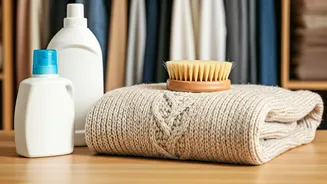Gentle Washing Procedures
The first 'do' is to wash woollens with care. Always opt for a gentle hand wash or use the delicate cycle on your washing machine. Harsh detergents can
damage wool fibres; therefore, it's best to select a mild detergent formulated for delicate fabrics or wool. When hand washing, use lukewarm water and gently agitate the garment. Avoid twisting or wringing the fabric, as this can distort its shape. Instead, gently squeeze out excess water. Be mindful of the temperature; hot water can cause shrinkage. It is advisable to always check the care label on your garment before washing to ensure the best results and avoid any potential damage. This initial step is fundamental in maintaining the quality of your woollens and preventing premature wear.
Correct Drying Techniques
Next, proper drying techniques are vital. Never put woollens in a tumble dryer. The heat can shrink and damage the fibres. Instead, reshape the wet garment and lay it flat on a clean, dry surface, such as a towel. Avoid hanging woollens, as the weight of the water can cause them to stretch out of shape. Ensure that the drying area is well-ventilated but away from direct sunlight or heat, which can cause colours to fade. Regularly check on the garment to ensure it's drying evenly and to prevent any potential issues. Proper drying is crucial to maintaining the original shape and size of your woollen clothes.
Appropriate Storage Practices
When storing your woollens, the next 'do' is to fold them neatly. Folding rather than hanging prevents stretching and distortion, maintaining the garment's original form. Place clean, dry woollens in a cool, dark, and dry place. Consider using breathable storage bags or containers to protect them from dust, pests, and moisture. Adding cedarwood balls or lavender sachets to your storage containers can help to repel moths and other insects, which can damage wool fibres. Regularly check your stored woollens for any signs of damage or infestation. By following these guidelines, you can ensure your woollens remain in excellent condition.
Protect From Pests
The next point of focus is protecting your woollens from pests. Before storing, ensure your woollens are thoroughly cleaned, as moths are attracted to food stains and body oils. Utilize moth repellents like cedarwood blocks, lavender sachets, or mothballs, but be cautious with mothballs as they have a strong odour. Store woollens in airtight containers or bags to prevent pests from reaching them. Periodically inspect your storage area for any signs of infestation, such as small holes or larvae. Regular checks and preventive measures are crucial to safeguarding your woollen garments from pest damage, ensuring they last longer.
Seasonal Rotation Strategy
Finally, the fifth 'do' is to rotate your woollens seasonally. Before putting away your winter clothes, take a moment to assess their condition. Repair any minor damages, such as loose threads or small tears. Clean and properly store the garments to prepare them for the next season. When bringing them out, re-inspect each item and give them a quick refresh, such as airing them out or a light hand wash if needed. Rotate your woollens with the seasons to ensure they remain in the best condition. Proper storage and seasonal checks will contribute to your woollens' longevity and ensure they remain in top shape year after year, ready for the colder months ahead.
Avoid Hot Water
Now, onto the 'don'ts', starting with avoiding hot water. Heat can cause wool fibres to shrink and felt, ruining the garment's shape and texture. Stick to lukewarm or cold water for washing. Always check the care label for specific instructions, but generally, hot water is a no-go for woollens. Ensure that the water temperature is appropriate to protect the fibres. The aim is to preserve the integrity of the woollen fabrics, preventing shrinking and maintaining their original fit, so it is crucial to avoid hot water during both washing and rinsing processes.
Don't Tumble Dry
The second 'don't' is to avoid tumble drying your woollens. The high heat of a tumble dryer can lead to shrinkage and damage. Instead, always air dry your woollen garments flat. Lay them on a clean, dry surface, preferably a towel, to absorb excess water and maintain their shape. Never hang woollens to dry, as the weight of the water can cause them to stretch out of shape. Ensure that the drying area is well-ventilated, and avoid direct sunlight. This step is essential in preserving the form and texture of your woollen clothes. Protecting them from heat will significantly extend their lifespan.
Refrain From Overwashing
Next, the 'don't' is to refrain from overwashing. Excessive washing can lead to wear and tear. Woollens are naturally resistant to dirt and odours, so frequent washing is unnecessary. Washing them only when needed extends their life. Spot clean stains promptly to avoid the need for a full wash. Air out your woollens regularly to freshen them up. Consider using a gentle wool detergent to minimize damage during cleaning. By washing only when necessary, you can maintain the quality and appearance of your woollen clothing. This will help them stay in good condition for longer.
Skip Harsh Chemicals
Another 'don't' is to avoid harsh chemicals. Bleach, strong detergents, and fabric softeners can damage wool fibres. Use mild detergents specifically designed for delicate fabrics or wool. These are formulated to clean effectively without causing harm. Fabric softeners can also diminish the natural properties of the wool. Read the labels carefully to make certain that any cleaning agent is suitable for use on woollens. By avoiding harsh chemicals, you protect the fibres and maintain the softness and integrity of your garments. Opting for gentle options will help preserve the quality of your woollen items.
No Direct Sunlight
The final 'don't' is to avoid direct sunlight. Prolonged exposure to sunlight can cause woollens to fade and become discoloured. When drying your woollens, always choose a shaded area. Sunlight can also weaken the fibres, reducing the lifespan of your garments. Store your woollens in a cool, dark place away from direct sunlight when they are not in use. Following this guideline will help maintain the colour and quality of your woollen items. This will help your clothes remain in top condition for years, preserving their appearance and prolonging their usability.










